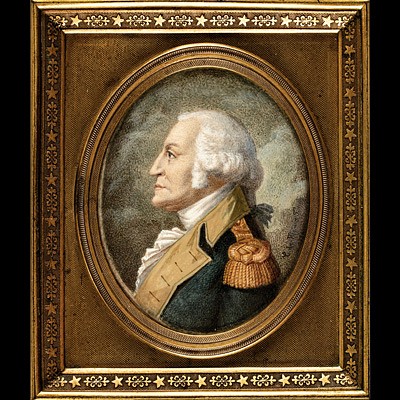c 1806 Robert Fulton Hand-Painted Portrait Snuff Box after Benj. Wests Painting
Lot 136
Estimate:
$2,200 - $2,800
Absentee vs Live bid
Two ways to bid:
- Leave a max absentee bid and the platform will bid on your behalf up to your maximum bid during the live auction.
- Bid live during the auction and your bids will be submitted real-time to the auctioneer.
Bid Increments
| Price | Bid Increment |
|---|---|
| $0 | $10 |
| $200 | $20 |
| $300 | $25 |
| $500 | $50 |
| $1,000 | $100 |
| $2,000 | $200 |
| $3,000 | $250 |
| $5,000 | $500 |
| $10,000 | $1,000 |
| $20,000 | $2,000 |
| $30,000 | $2,500 |
| $50,000 | $5,000 |
| $100,000 | $10,000 |
| $200,000 | $20,000 |
| $300,000 | $25,000 |
| $500,000 | $50,000 |
About Auction
By Early American History Auctions
May 22, 2021
Set Reminder
2021-05-22 12:00:00
2021-05-22 12:00:00
America/New_York
Bidsquare
Bidsquare : Autographs-Colonial-Political-Americana
https://www.bidsquare.com/auctions/early-american-history-auctions/autographs-colonial-political-americana-6913
302 Lots of Rare, Historic Autographs, Americana, Civil War Era, George Washington, Abraham Lincoln, Slavery & Black History, Revolutionary War Era, Colonial America, Federal Period, War of 1812, Colonial Currency, Indian Peace Medals & more... Early American History Auctions auctions@earlyamerican.com
302 Lots of Rare, Historic Autographs, Americana, Civil War Era, George Washington, Abraham Lincoln, Slavery & Black History, Revolutionary War Era, Colonial America, Federal Period, War of 1812, Colonial Currency, Indian Peace Medals & more... Early American History Auctions auctions@earlyamerican.com
- Lot Description
Federal Period
Robert Fulton Hand-Painted Portrait Decorated Snuff Box
c. 1806 Federal Period, Excellent Hand-Painted Robert Fulton Portrait Snuff Box, after the Portrait Painting by Benjamin West in 1806, Extremely Fine.
An appealing Hand-painted Papier-mch Snuff Box measuring 3.25" in diameter depicting Robert Fulton, the inventor of the steamboat on the top lid, the likeness after Benjamin West's 1806 Portrait of Fulton. Light normal crackel is expected and of little consequence with some minor chipping loss to interior (unseen) edge lip with some irregularity to the surface being overall, handsome and attractive. The black underside of the lid is Inscribed, "Robert Fulton Esqr" (not in his hand).
Robert Fulton (November 14, 1765 - February 25, 1815) was an American engineer and inventor who is widely credited with developing a commercially successful steamboat; the first was called North River Steamboat (later Clermont).
In 1807 that steamboat traveled on the Hudson River with passengers, from New York City to Albany and back again, a round trip of 300 miles (480 km), in 62 hours. The success of his steamboat changed river traffic and trade on major American rivers.
In 1800, Fulton had been commissioned by Napoleon Bonaparte, leader of France, to attempt to design a submarine; he produced Nautilus, the first practical submarine in history. Fulton is also credited with inventing some of the world's earliest naval torpedoes for use by the British Royal Navy.
Fulton became interested in steam engines and the idea of steamboats in 1777 when he was around age 12 and visited state delegate William Henry of Lancaster, Pennsylvania, who was interested in this topic. Henry had learned about inventor James Watt and his Watt steam engine on an earlier visit to England.
From 1811 until his death, Fulton was a member of the Erie Canal Commission, appointed by the Governor of New York.
Fulton's final design was the floating battery Demologos. This first steam-driven warship in the world was built for the United States Navy for the War of 1812. The heavy vessel was not completed until after Fulton's death and was named for him in his honor.
From October 1811 to January 1812, Fulton, along with Livingston and Nicholas Roosevelt (1767-1854), worked together on a joint project to build a new steamboat, New Orleans, sturdy enough to take down the Ohio and Mississippi rivers to New Orleans, Louisiana. It traveled from industrial Pittsburgh, Pennsylvania, where it was built, with stops at Wheeling, Virginia; Cincinnati, Ohio; past the "Falls of the Ohio" at Louisville, Kentucky; to near Cairo, Illinois, and the confluence with the Mississippi River; and down past Memphis, Tennessee, and Natchez, Mississippi, to New Orleans some 90 miles (140 km) by river from the Gulf of Mexico coast. This was less than a decade after the United States had acquired the Louisiana Territory from France. These rivers were not well settled, mapped, or protected. By achieving this first breakthrough voyage and also proving the ability of the steamboat to travel upstream against powerful river currents, Fulton changed the entire trade and transportation outlook for the American heartland.
Fulton was elected a member of the American Antiquarian Society in 1814
Our Auction Contents:
Black History & Slavery: (Lots 1 - 63)
Abraham Lincoln Related: (Lots 64 - 74)
Historic Autographs: (Lots 75 - 235)
Colonial America: (Lots 236 - 261)
Revolutionary War: (Lots 262 - 304)
George Washington Related: (Lots 305 - 306)
Early American Guns & Weapons: (Lots 307 - 318) - Shipping Info
-
Early American provides in-house worldwide shipping. Please contact us directly if you have questions about your specific shipping requirements.
-
- Buyer's Premium



 EUR
EUR CAD
CAD AUD
AUD GBP
GBP MXN
MXN HKD
HKD CNY
CNY MYR
MYR SEK
SEK SGD
SGD CHF
CHF THB
THB













